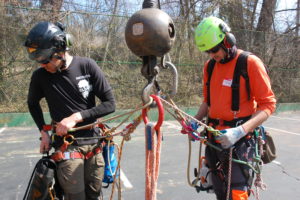On a recent rifle hunt in the Weiser State Forest, I was making my way from a maturing Oak stand on a north facing slope through a clear cut growing in with Maple, Birch and Oak saplings some ten years old or so. I looked down, following along the dark, acidic soil of the single track trail that casted tracks of a single deer. The trail eventually merged onto a forest road, and I followed it towards a power line up ahead.
I observed several buck rubs along the way, on the young saplings bordering in the margin of the clearcut and the road. There was Switchgrass planted along the north side of the road in sections several feet wide, and in a small food plot that may have been a log landing or equipment staging area for the silviculture operations in the past. As I proceeded down the road to the west, a little bit of brown marcescence caught my attention.

I had known Sweetfern previously from the heath barrens on top of Moosic Mountain at the Dick and Nancy Eales Preserve, a property owned by the Nature Conservancy. It grows en masse together along the trail edges there as well. That habitat, too, is an acidic, barren landscape that holds large populations of Pitch Pine, Sweetfern, Chestnut Oak and Lowbush Blueberry.
Comptonia peregrina is not a fern, but a low woody shrub, and according to the Peterson Field Guide, provides browse for both ruffed grouse and Whitetail deer. In fact, I have flushed growse on each of my visits to the Taylorsville tract of Weiser State Forest, and I must believe it is in part because of the nutrition and cover that Sweetfern provides those birds.
When crushed, the twigs and leaves of Sweetfern are aromatic, which reminds me of another fragrant plant, the Sassafras that is sprouting from stump suckers in the clear cuts on the top of the mountain that we walked through earlier this morning, trying to kick out a deer. To two fragrances are different though, sweet and spicy.

Sweetfern is almost tropical in its appearance, a nitrogen fixer that thrives in either boggy or dry, sandy soils, both of which can be found in the higher elevations of Northeast PA. Nestled in amongst the effects of the last ice age, or the last timber stand improvement operation, it connects several landscapes in my mind, for whatever reason, of both the recent and deep past.






Leave a Reply
Your email is safe with us.